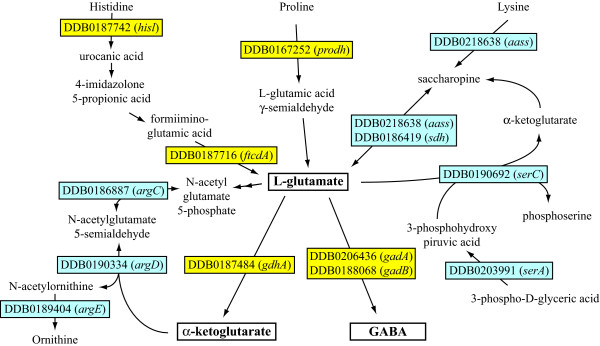Figure 9.
Regulation of glutamate metabolic pathway by phagocytic stimuli inferred by the gene expression profile. Twenty genes involved in aminoacid metabolism are detected in the DNA microarray. Of these, 14 are directly or indirectly linked to glutamate metabolism, as shown in the Figure. Over- and under-expressed genes are shown in yellow and grey, respectively. GadA (DDB0206436) and gadB (DDB0188068), encode the glutamate decarboxylase A and B [51], respectively and are strongly over-expressed. Up-regulated are also a putative proline dehydrogenase (prodhA, DDB0167252), which catalyzes the formation of L-glutamic acid γ-semialdehyde, the histidine ammonia lyase (hisl, DDB0187742) and the glutamic acid formiiminotransferase (ftcdA, DDB0187716), which are both involved in the major pathway for converting histidine to glutamic acid. Up-regulated is also the gene for the 10-formyltetrahydrofolate synthetase (fths, DDB0188868), which generates a potential substrate for the formiimino group released by the formiiminotransferase. Slightly up-regulated is also the gene for the glutamate dehydrogenase (gdhA, DDB0187484), which leads to α-ketoglutarate formation from L-glutamic acid. Downregulated are seven genes encoding putative enzymes involved in the conversion of L-glutamic acid to, respectively, L-ornithine (argC, DDB0186887, argD, DDB0190334 and argE, DDB0189404), serine (serA, DDB0203991 and serC, DDB0190692) or lysine (aass, DDB0218638 and sdh, DDB0186419). In the assumption that the regulation of all these genes is reflected at enzymatic level, a preferential accumulation of glutamate and its conversion to GABA and α-ketoglutarate could be inferred.

